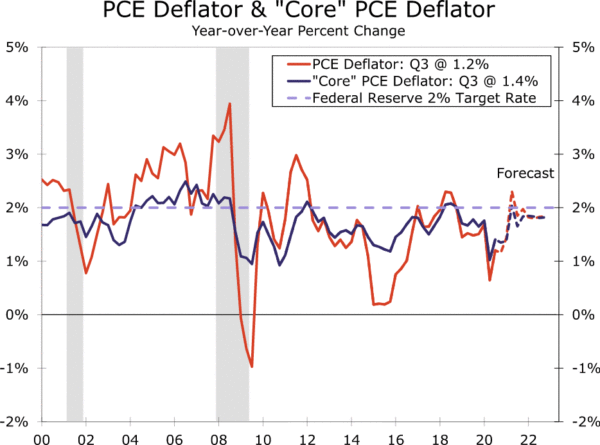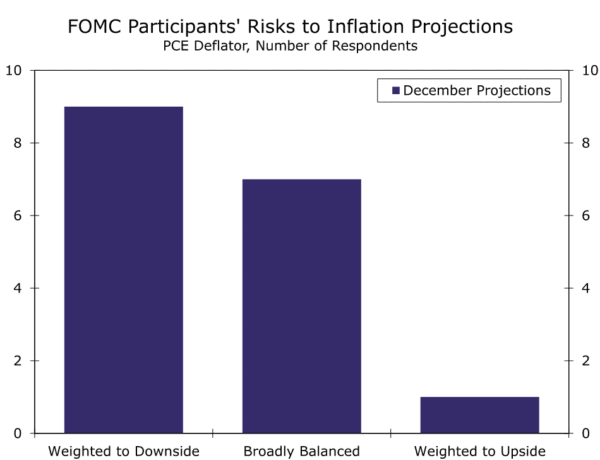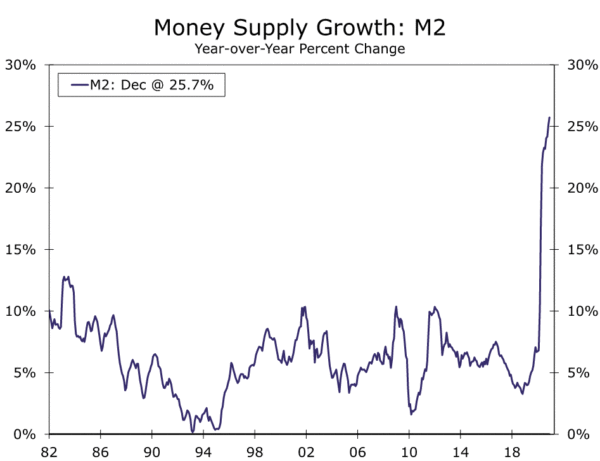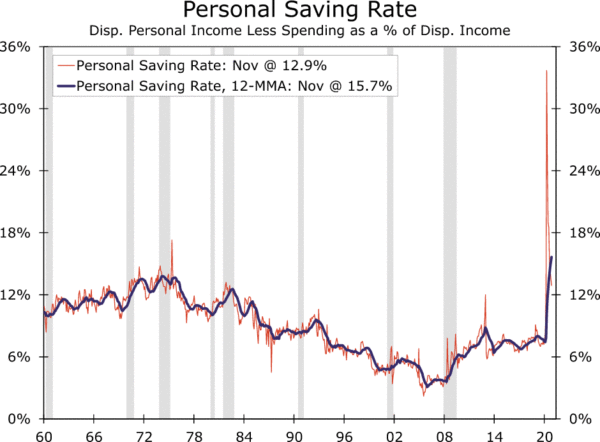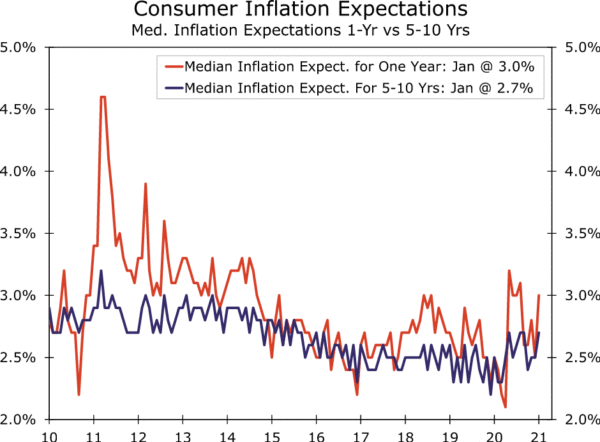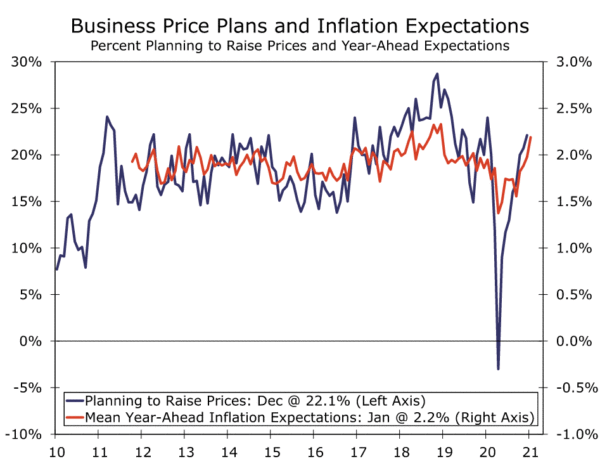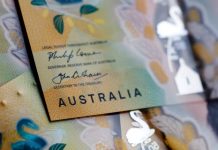Part II: Poking the Inflation Bear
Summary
In the second installment of our series on economic risks in the foreseeable future, we analyze the potential for higher inflation in coming years stemming from excess demand. Our base case looks for the rate of PCE inflation to rise to 1.9% in 2021 from an estimated rate of 1.2% last year. But, we acknowledge the risk that inflation could turn up more markedly this year than our forecast. Multiple rounds of direct government aid have left many households flush with excess savings which, coupled with pent-up demand, especially for services, could lead to robust consumer spending that causes prices to shoot higher as the year progresses.
That said, inflation is a process, and it will take more than one-off price changes for inflation to be sustained. But an unmooring of inflation expectations, should that occur, could break the psychology of low inflation that became entrenched over the past decade. Expectations of higher inflation often beget higher inflation. In that regard, inflation expectations among consumers, businesses and market participants have edged up recently.
If our forecast of benign inflation turns out to be reasonably accurate, then the Federal Open Market Committee (FOMC) likely will not be spooked into pulling forward its expected timeline of monetary tightening. But, a significant rebound in inflation in the next year or two could potentially derail the recovery from the COVID-induced economic downturn by leading the Fed to raise rates sooner and/or higher than most market participants currently expect.
After Plummeting Last Spring, Inflation Heading Higher
Like many parts of the economy, the inflation environment has been rocked by COVID. Sudden stay-at-home orders last spring sent prices plunging for a host of goods and services, such as apparel, cars, gasoline, hotels and airfare. Inflation, as measured by the PCE deflator, was a hair shy of the FOMC’s 2% goal in January 2020, but it tumbled to 0.5% three months later. In a rare occurrence, the core PCE deflator posted back-to-back monthly declines in March and April.
As vaccinations rise and economic activity returns to some semblance of “normal,” we expect inflation to firm over the course of 2021. Core PCE inflation is likely to hit the Fed’s 2% goal as early as the second quarter, helped by easy base comparisons after last spring’s plunge in prices. But, base comparisons will be harder in the second half of 2021 following the initial post-lockdown rebound in prices early last summer. Although core inflation in coming months should be noticeably higher than in 2020, we anticipate that it will struggle to stay at 2% in the second half of this year and into 2022 (Figure 1).
Fed officials appear to agree. In the FOMC’s Summary of Economic Projections in December, the median estimate for both headline and core PCE was 1.8% for Q4-2021 and 1.9% by Q4-2022. Moreover, most Fed officials viewed the risks to inflation as weighted to the downside (Figure 2).
The restrained outlook on inflation follows a decade in which it struggled to meet the Fed’s target of 2%, averaging just 1.6% in the 2010s. The prolonged undershoot has sparked a change in how the FOMC approaches its price mandate. Rather than aiming to get inflation as close to 2% as possible at any given time, the FOMC now seeks price growth to average 2% over time and is comfortable with inflation running modestly above 2% following periods in which it undershoots 2%. As a result, economists and market participants widely expect the FOMC to keep the fed funds rate unchanged until at least 2023, even as core inflation moves back near 2%. But, could the FOMC be wrong about the direction of risks to the inflation outlook? Could inflation strengthen more substantially and pull forward the timing of Fed policy tightening?
It’s Not Just Base Effects That Could Lift Inflation
The COVID recession has been unlike any other. The size and speed of the downturn has been unprecedented, but so has the policy response. In the span of a month, the FOMC slashed its target range for the fed funds rate by 150 bps, which returned it to its lower bound of 0.00% to 0.25%. The FOMC also sanctioned $1.7 trillion worth of asset purchases, and it put in place a number of lending programs. Furthermore, the fiscal policy response was also forceful. The CARES Act passed in March and the follow-up relief bill signed in December has put trillions of dollars directly into the hands of businesses and households. The current policy response contrasts sharply with the programs that were put in place following the 2008-2009 financial crisis, when aid primarily went toward shoring up the banking system. As a result, the money supply has soared at its fastest pace in decades (Figure 3).
Yet, inflation remains benign. The lack of inflation despite the sizable bout of deficit spending and acceleration in the money supply appears to defy the predictions of Keynesians and Monetarists alike. However, demand has tumbled due to health considerations, not just on account of the usual recessionary dynamics of job and income losses. Consumers have been unable to spend in the same way they did prior to COVID. The pandemic has forced thrift upon households seeking to avoid higher-risk activities that are not a necessity, like travel, inside dining and entertainment. As a result of the massive fiscal support and inability to safely spend in the same way, the saving rate shot up significantly in April and remains elevated (Figure 4). We estimate consumers are sitting on $1.5 trillion in excess savings compared to the saving rate’s pre-COVID trend.
At the same time, consumers are fatigued by virus mitigation efforts. After a year of limiting trips, eating at home and putting off doctor appointments, we expect consumers will be eager to engage in many of the in-person services forgone during the pandemic, and spend on gas to get there and clothes to look good doing it. The ample means and eagerness to spend could potentially set off a bout of demand-driven inflation that has not been experienced in decades.
Higher Inflation Expectations Cement the Post-Pandemic Reflation?
On its own, a reopening-driven rebound in inflation is unlikely to spook the FOMC. Inflation is a process. In order for higher inflation to be sustained, prices need to continue rising at a faster pace. In other words, one-time price increases do not generate higher inflation on an ongoing basis.
That said, a single spike in prices could shape inflation expectations and make it easier for initial hikes to be followed up with further increases or for a wider array of businesses to adjust prices. Inflation expectations have trended higher in recent months, which could help the process of accelerating prices unfold. Inflation expectations among households have moved up (Figures 5), shaped in part by higher prices for items in high demand, (e.g., groceries). However, official inflation indices have been restrained by price declines for items for which consumers have largely shunned since the pandemic began (e.g., travel). Meanwhile, business inflation expectations are rising as firms grapple with higher input costs and/or have benefited from shifting patterns of spending in the pandemic (Figure 6). The belief among businesses and households that inflation will be higher has the ability to become self-fulfilling.
Meanwhile, business inflation expectations are rising as firms grapple with higher input costs and/or have benefited from shifting patterns of spending in the pandemic (Figure 6). The belief among businesses and households that inflation will be higher has the ability to become self-fulfilling.
Cementing the recovery in expectations could be the FOMC’s new approach toward inflation. Under its new policy framework, the FOMC has indicated a higher degree of tolerance for inflation and will therefore be slower in raising interest rates. Higher realized inflation could push up inflation expectations among business and consumers even further, leading to a reinforcing circle.
Higher Inflation and Expectations—Fed Mission Accomplished?
Raising inflation expectations was a goal of the FOMC’s updated inflation framework. A strong rebound in inflation and a recovery in inflation expectations could lead the FOMC to declare victory on in its inflation goal. Fear that inflation subsequently becomes unbridled could potentially pull forward the timeline of policy normalization this year and generate a tightening in financial conditions, which could lead to a premature end to the budding recovery.
We readily acknowledge that the unique set of circumstances surrounding the COVID recession ushers in the risk of notably higher inflation this year. Yet, we believe that the prospect of both actual inflation and inflation expectations rising to a point where the Fed pulls forward its tightening plans is significantly smaller. Despite the prospect for demand-pull inflation, we anticipate inflation to soften in some categories that have been particular beneficiaries of the pandemic. Chief among them are goods. Even as spending strengthens across the board this year, we expect goods spending to lag after households pulled forward demand for furniture, cars and recreational items this year. Furthermore, as the pandemic eases, so too should the supply chain disruptions that have also put upward pressure on prices this past year. The weaker dollar will lead to higher import costs, all else equal, but overall the dollar has only a small bearing on goods prices, and we expect only moderate softening in its trade-weighted value. Meanwhile, on the services side, housing inflation is also likely to remain weak over the early part of the year, even with impressive sales price growth in recent months, given the lag in which market conditions are incorporated into inflation measures.
More generally, while the fiscal response to the crisis has been unprecedented and consumers are itching to get out and spend freely, not all corners of the economy are likely to be set right this year. Slack is expected to persist in the labor market, whether measured against the official unemployment rate or accounting for lower labor force participation, a topic to which we will return to explore in more detail in Part III of this series.
In addition, after years of inflation undershooting 2%, we suspect the FOMC will want to see how the dust settles in the post-COVID environment. If core PCE inflation moves above 2%, is it merely a reopening bounce, or the definitive exit of the sub-target era? The reasons for the stubbornly low inflation environment of the past decade are not fully understood, and as a result, we believe FOMC members will be humble in declaring the risk of disinflation behind us. Indeed, Fed officials have already indicated they will exert patience in responding to the potential for 2%+ inflation this year. For example, Fed Vice Chair Richard Clarida recently stated that “we’re not going to lift off until we get 2% inflation for a year.” Moreover, the FOMC is more confident in its ability to fight unwelcomely-high inflation than too-low inflation, which will likely lead it to error on the side of being behind the inflation curve than in front of it.
Yet even if the FOMC is unlikely to pull forward its plans for policy normalization, market participants may nonetheless perceive an accelerated timeline. Smooth communication between the Federal Reserve and markets is not a given. Questions over whether rising inflation and inflation expectations constitutes “moderately above 2%” or “substantial further progress” are likely to come to the forefront this year given the Fed’s new framework. It would not be the first time markets have gotten ahead of themselves or the Fed. Pricing of an earlier lift off in rates, even if that is not the Fed’s plan, could lead to an unintended tightening of financial conditions that would slow the economy’s recovery. Even if the FOMC remains patient, the potential jump in inflation would erode real returns among market participants and reduce consumer purchasing power, putting particular strain on lower-income households that have already borne disproportionate pain by the pandemic.
Conclusion
Year-over-year rates of consumer price inflation should move higher in coming months due, at least in part, to low base effects. But, the excess savings that many households have accumulated in conjunction with pent-up demand for many services could generate very robust growth in consumer spending later this year that could lead to some acceleration in prices. Although we expect that inflation largely will remain benign, we acknowledge that it could rise higher than our forecasts if inflation expectations should become unmoored. In that case, households could rush to buy goods and services before their prices rise even higher. A period of steadily rising inflation could be set in train by demand-side factors.
But, there are also issues on the supply side of the economy that could lead to higher inflation as well. For example, the permanent shuttering of thousands of businesses this year could reduce competition in some sector of the economy. Many businesses may try to rebuild profit margins by raising prices as the recovery gathers steam. Labor costs in some key sectors of the economy could accelerate, which could also put upward pressure on prices. We will address these supply side effects on inflation in our next report in this series.




